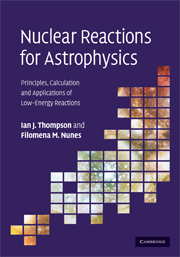Book contents
- Frontmatter
- Contents
- Preface
- Sources of quotations
- Acknowledgements
- 1 Nuclei in the Cosmos
- 2 Reactions of nuclei
- 3 Scattering theory
- 4 Reaction mechanisms
- 5 Connecting structure with reactions
- 6 Solving the equations
- 7 Approximate solutions
- 8 Breakup
- 9 Three-body nuclei
- 10 R-matrix phenomenology
- 11 Compound-nucleus averaging
- 12 Stellar reaction rates and networks
- 13 Connection to experiments
- 14 Spectroscopy
- 15 Fitting data
- Appendix A Symbols
- Appendix B Getting started with Fresco
- Select bibliography
- Index
3 - Scattering theory
Published online by Cambridge University Press: 05 March 2012
- Frontmatter
- Contents
- Preface
- Sources of quotations
- Acknowledgements
- 1 Nuclei in the Cosmos
- 2 Reactions of nuclei
- 3 Scattering theory
- 4 Reaction mechanisms
- 5 Connecting structure with reactions
- 6 Solving the equations
- 7 Approximate solutions
- 8 Breakup
- 9 Three-body nuclei
- 10 R-matrix phenomenology
- 11 Compound-nucleus averaging
- 12 Stellar reaction rates and networks
- 13 Connection to experiments
- 14 Spectroscopy
- 15 Fitting data
- Appendix A Symbols
- Appendix B Getting started with Fresco
- Select bibliography
- Index
Summary
I am now convinced that theoretical physics is actually philosophy.
Max BornIn order to find the cross sections for reactions in terms of the interactions between the reacting nuclei, we have to solve the Schrödinger equation for the quantum mechanical wave function. Scattering theory tells us how to find these wave functions for the positive (scattering) energies that are needed. We start with the simplest case of finite spherical real potentials between two interacting nuclei in Section 3.1, and use a partial-wave analysis to derive expressions for the elastic scattering cross sections. We then progressively generalize the analysis to allow for long-ranged Coulomb potentials, and also complex-valued optical potentials. Section 3.2 presents the quantum mechanical methods to handle multiple kinds of reaction outcomes, each outcome being described by its own set of partial wave channels, and Section 3.3 then describes how multi-channel methods may be reformulated using integral expressions instead of sets of coupled differential equations. We end the chapter by showing in Section 3.4 how the Pauli principle requires us to describe sets of identical particles, and by showing in Section 3.5 how Maxwell's equations for an electromagnetic field may, in the one-photon approximation, be combined with the Schrödinger equation for the nucleons. Then we can describe photo-nuclear reactions, such as photo-capture and disintegration in a uniform framework.
Elastic scattering from spherical potentials
When the potential between two interacting nuclei does not depend on the orientiation of the vector between them, we say that the potential is spherical.
- Type
- Chapter
- Information
- Nuclear Reactions for AstrophysicsPrinciples, Calculation and Applications of Low-Energy Reactions, pp. 48 - 128Publisher: Cambridge University PressPrint publication year: 2009



